
Best Earth Images of the Month - July 2012
Blessing from the sea

Melissa Pelaez was visiting Panama to do research on yellowfin tuna for her master's degree in aquaculture, the cultivation or farming of fish. One fine morning she and her University of Miami classmates set out from the Achotines Laboratory to catch adult tuna, which they planned to bring back to the station from the Pacific Ocean to breed.
But the fish weren't biting very well that morning, July 13, and after several hours Pelaez had caught only two bonitos, unappetizing baitfish. She was discouraged, hungry and lost in thought when she heard the ship's captain yell "
Reaching rare heights

Most of the time, Chris Kirby chases storms, but sometimes they come to him. During a drive through the mountains this Saturday afternoon (July 28) near his home in Aurora, Colo., to photograph mountain goats and test radio equipment, he got quite a surprise: a rare, high-elevation tornado.
"The funnel briefly touched down on a ridge, just enough to be deemed a tornado," Kirby said. "I'm blessed to have seen such an extremely rare phenomenon."
[Full Story: Rare Colorado Tornado Second-Highest in US History]
A touch of light
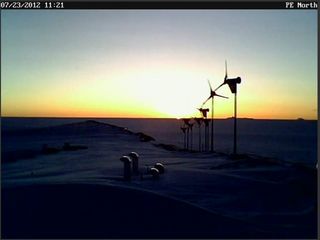
A lonely webcam at an Antarctic station recently captured images of the first sunrise to light the sky in two months, marking the end of winter darkness in its neighborhood of East Antarctica.
The sun set for austral winter in mid-May, plunging Belgium's Princess Elisabeth Station into two months of night.
[Full Story: First Sunrise of Season Blazes into Antarctic View]
Snapping good photos
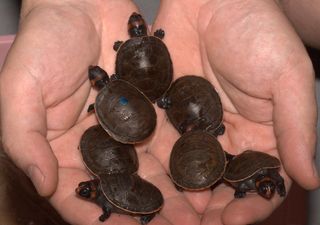
A big baby boom of teeny turtles has hit the Tennessee Aquarium, and keepers have their hands full caring for their newly-hatched charges, among them some rare species whose populations are facing steep declines in the wild.
The Chattanooga institution has welcomed 20 reptilian bundles of joy in recent weeks.
[Full Story: Photo: Host of Tiny Turtles Born at Aquarium]
Ten years in the making

A process more than a decade in the making reached its climactic moment this week, when a giant iceberg finally broke away from the floating end of a Greenland glacier and a passing satellite captured the drama on camera.
On Monday, a massive iceberg larger than Manhattan was birthed from the Petermann Glacier, one of the largest in Greenland, and began to float toward the open ocean.
[Full Story: Photo: Giant Iceberg's Birth Snapped from Space]
Odd storm clouds
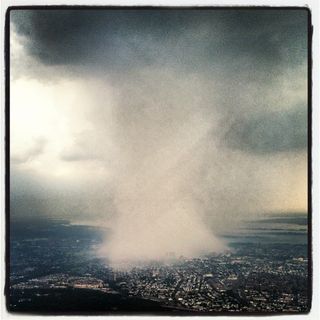
Former NFL player Dhani Jones posted this photo of a ghostly column of rain over Queens, N.Y., yesterday to his Twitter account (@dhanijones), which he says he took from a Delta flight at 10,000 feet.
Jones posted the astounding photo from his Instagram account shortly before a larger system of storms hit, which dropped nearly 2 inches (5 centimeters) of rain in many parts of the city.
[Full Story: Photo: Strange Storm Socks New York City]
Eerie curtains
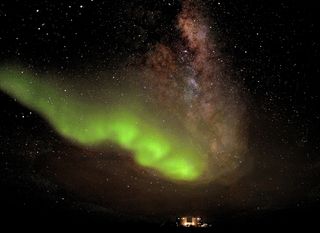
The handful of wintertime residents at an isolated Antarctica research station recently got a break from austral winter's 24-hour darkness when a shimmering aurora blazed to life over their lonely outpost in the middle of the East Antarctic Ice Sheet.
A photograph snapped on Wednesday (July 18) shows unearthly green curtains of light hovering above Concordia Station, a joint European research site run by the French Polar Institute and the Italian Antarctic Program, and one of the most hard-to-reach places on the planet.
[Full Story: Photo: Dazzling Aurora Appears Over Antarctic Station]
Sign up for the Live Science daily newsletter now
Get the world’s most fascinating discoveries delivered straight to your inbox.
Home sweet home
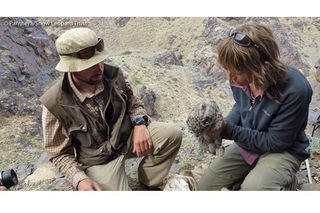
Panthera's Snow Leopard Field Scientist O?rjan Johansson and veterinarian Carol Esson (Australia) examine and prepare to weigh a cub.
[More Images: Rare Photos: Snow Leopard Babies in Dens]
Smoke sucking clouds
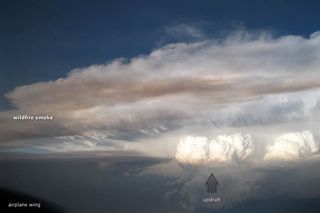
NASA scientists on a recent research flight got an eyeful when their plane encountered a massive supercell thunderstorm gobbling up smoke from wildfires ?a phenomenon rarely glimpsed up close, and one that scientists are eager to study.
On June 22, one of the researchers aboard a DC-8 aircraft snapped images of curtains of thick, gray smoke being lofted high into the atmosphere and sucked up through soaring, anvil-shaped clouds that are the signature of large thunderstorms.
[Full Story: Dramatic Photos Show Wildfire Smoke Sucked Up by Storm]
Not so mythical sight

Near the edge of space, sprites and elves dance, but there's nothing mythical about them.
Sprites and elves are reddish, ultrafast bursts of electricity that are born near the edge of space, about 50 miles (80 kilometers) up in the atmosphere. Sprites are jellyfish-shaped, starting as balls of light that stream downward, whereas elves take the shape of ring-like halos.
[Full Story: Astronaut Photo Captures Elusive, Strange Lightning]
Welcome night light

Soon after the 24-hour darkness of Antarctic winter descended on the United States' Amundsen-Scott Station at the South Pole, the crew of scientists and staff overwintering there got a much-welcomed dose of very bright moonlight.
In early May, a gleaming supermoon appeared this full moon coincides with the moon's perigee, or closest monthly pass of the Earth.
[Full Story: Supermoon Lights Up South Pole in Photo]

